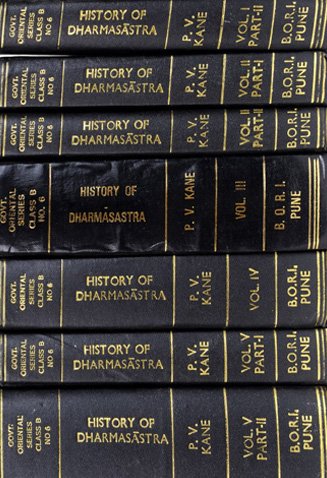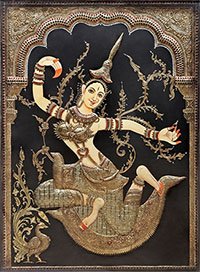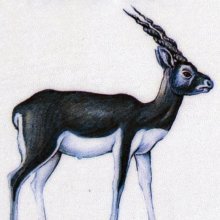Krishnasara, Kṛṣṇasāra, Krishnashara, Kṛṣṇaśāra, Krishna-shara, Krishna-sara: 15 definitions
Introduction:
Krishnasara means something in Hinduism, Sanskrit, Marathi, biology. If you want to know the exact meaning, history, etymology or English translation of this term then check out the descriptions on this page. Add your comment or reference to a book if you want to contribute to this summary article.
The Sanskrit terms Kṛṣṇasāra and Kṛṣṇaśāra can be transliterated into English as Krsnasara or Krishnasara or Krishnashara, using the IAST transliteration scheme (?).
Images (photo gallery)
In Hinduism
Dharmashastra (religious law)
Source: Prācyā: Animals and animal products as reflected in Smṛti textsKṛṣṇasāra (कृष्णसार) refers to the animal “Black buck” (Antelope cervacapra).—The Smṛtis mention several domestic as well as wild animals that are enumerated in context of specifying expiation for killing them, the flesh being used as a dietary article to give satisfaction to the Manes (Pitṛs) in Śrāddha rites, the law of transmigration due to various sins committed as well as in the context of specifying gifts to be given on various occasions. These animals [viz., Kṛṣṇasāra] are chiefly mentioned in the Manusmṛti, Parāśarasmṛti [Chap.6], Gautamasmṛti [17.2 and 15.1], Śātātapasmṛti [II.45-54], Uśānasmṛti [IX.7-9; IX.12-13], Yājñavalkyasmṛti [I.170-171; I.175; I.258- 260], Viṣṇusmṛti [51.3;51.6;51.26;51.33;80.3-14], Uttarāṅgirasasmṛti [X.15-17], Prajāpatismṛti [Śrāddhatyājyavastuvarṇanam. 138-143], 9 Kāśyapasmṛti [Section on Prāyaścittavarṇanam], Vṛddha Hārītasmṛti [6.253-255] and Kātyāyanasmṛti [27.11].

Dharmashastra (धर्मशास्त्र, dharmaśāstra) contains the instructions (shastra) regarding religious conduct of livelihood (dharma), ceremonies, jurisprudence (study of law) and more. It is categorized as smriti, an important and authoritative selection of books dealing with the Hindu lifestyle.
Ayurveda (science of life)
Veterinary Medicine (The study and treatment of Animals)
Source: Shodhganga: Portrayal of Animal Kingdom (Tiryaks) in Epics An Analytical studyKṛṣṇasāra (कृष्णसार) refers to the Black buck (Anlelope cervacapra), according to scientific texts such as the Mṛgapakṣiśāstra (Mriga-pakshi-shastra) or “the ancient Indian science of animals and birds” by Hamsadeva, containing the varieties and descriptions of the animals and birds seen in the Sanskrit Epics such as the Ramayana and Mahabharata.

Āyurveda (आयुर्वेद, ayurveda) is a branch of Indian science dealing with medicine, herbalism, taxology, anatomy, surgery, alchemy and related topics. Traditional practice of Āyurveda in ancient India dates back to at least the first millenium BC. Literature is commonly written in Sanskrit using various poetic metres.
Yoga (school of philosophy)
Source: ORA: Amanaska (king of all yogas): A Critical Edition and Annotated Translation by Jason BirchKṛṣṇasāra (कृष्णसार) refers to the “spotted black deer”, according to the Yogatārāvalī: a short Yoga text of twenty-nine verses presenting Haṭhayoga as the means to Rājayoga (i.e., Samādhi).—Accordingly, while describing the no-mind state: “Let this mind wander into thoughtless Samādhi or into a pair of voluptuous breasts of [women] whose eyes are [as alluring as those of] the spotted black deer (kṛṣṇasāra). Let it roam among the thoughts of idiots or the thoughts of the wise. The merits and faults produced by thought do not touch me, the king [of Rājayoga]”.

Yoga is originally considered a branch of Hindu philosophy (astika), but both ancient and modern Yoga combine the physical, mental and spiritual. Yoga teaches various physical techniques also known as āsanas (postures), used for various purposes (eg., meditation, contemplation, relaxation).
Sports, Arts and Entertainment (wordly enjoyments)
Source: archive.org: Syainika Sastra of Rudradeva with English Translation (art)Kṛṣṇasāra (कृष्णसार) refers to “antelopes” (which were commonly the victim of hunters), according to the Śyainika-śāstra: a Sanskrit treatise dealing with the divisions and benefits of Hunting and Hawking, written by Rājā Rudradeva (or Candradeva) in possibly the 13th century.—Accordingly, “Hunting by packs of dogs is that in which dogs are let loose at hares and other animals in arid tracts. [...] This has a subdivision named Rajvāmoka, which is employed in capturing antelopes (kṛṣṇasāra) and deer, and in which the string (lasso?) is cast. with skill. [...]”.

This section covers the skills and profiencies of the Kalas (“performing arts”) and Shastras (“sciences”) involving ancient Indian traditions of sports, games, arts, entertainment, love-making and other means of wordly enjoyments. Traditionally these topics were dealt with in Sanskrit treatises explaing the philosophy and the justification of enjoying the pleasures of the senses.
Biology (plants and animals)
Source: Google Books: CRC World Dictionary (Regional names)Krishnasara in India is the name of a plant defined with Dalbergia sissoo in various botanical sources. This page contains potential references in Ayurveda, modern medicine, and other folk traditions or local practices It has the synonym Dalbergia sissoo Roxb., nom. illeg. (among others).
Example references for further research on medicinal uses or toxicity (see latin names for full list):
· Revisio Generum Plantarum (1891)
· Hortus Bengalensis, or ‘a Catalogue of the Plants Growing in the Hounourable East India Company's Botanical Garden at Calcutta’ (1814)
· Prodromus Systematis Naturalis Regni Vegetabilis (1825)
· Annals of the Missouri Botanical Garden (1981)
· Applied Entomology and Zoology (2008)
· The Civil and Natural History of Jamaica (1756)
If you are looking for specific details regarding Krishnasara, for example pregnancy safety, extract dosage, health benefits, chemical composition, diet and recipes, side effects, have a look at these references.

This sections includes definitions from the five kingdoms of living things: Animals, Plants, Fungi, Protists and Monera. It will include both the official binomial nomenclature (scientific names usually in Latin) as well as regional spellings and variants.
Languages of India and abroad
Marathi-English dictionary
Source: DDSA: The Aryabhusan school dictionary, Marathi-Englishkṛṣṇasāra (कृष्णसार).—m The black antelope.
Marathi is an Indo-European language having over 70 million native speakers people in (predominantly) Maharashtra India. Marathi, like many other Indo-Aryan languages, evolved from early forms of Prakrit, which itself is a subset of Sanskrit, one of the most ancient languages of the world.
Sanskrit dictionary
Source: DDSA: The practical Sanskrit-English dictionaryKṛṣṇaśāra (कृष्णशार).—the spotted antelope; कृष्णसारे ददच्चक्षुस्त्वयि चाधिज्यकार्मुके (kṛṣṇasāre dadaccakṣustvayi cādhijyakārmuke) Ś.1.6; V.4.31; पीयूषभानाविव कृष्णसारः (pīyūṣabhānāviva kṛṣṇasāraḥ) Rām. Ch.1.3.
Derivable forms: kṛṣṇaśāraḥ (कृष्णशारः).
Kṛṣṇaśāra is a Sanskrit compound consisting of the terms kṛṣṇa and śāra (शार). See also (synonyms): kṛṣṇasāra, kṛṣṇasāraṅga.
--- OR ---
Kṛṣṇasāra (कृष्णसार).—the spotted antelope; कृष्णसारे ददच्चक्षुस्त्वयि चाधिज्यकार्मुके (kṛṣṇasāre dadaccakṣustvayi cādhijyakārmuke) Ś.1.6; V.4.31; पीयूषभानाविव कृष्णसारः (pīyūṣabhānāviva kṛṣṇasāraḥ) Rām. Ch.1.3.
Derivable forms: kṛṣṇasāraḥ (कृष्णसारः).
Kṛṣṇasāra is a Sanskrit compound consisting of the terms kṛṣṇa and sāra (सार). See also (synonyms): kṛṣṇaśāra, kṛṣṇasāraṅga.
Source: Cologne Digital Sanskrit Dictionaries: Shabda-Sagara Sanskrit-English DictionaryKṛṣṇaśāra (कृष्णशार).—m.
(-raḥ) The black antelope: see kṛṣṇasāra.
--- OR ---
Kṛṣṇasāra (कृष्णसार).—mf.
(-raḥ-rā) A timber tree, Sisu, (Dalbergia Sisu, Rox.) m.
(-raḥ) 1. The black antelope. 2. Khayar, (Mimosa catechu.) 3. A thorny plant, (Euphorbia tirucalli, &c.) E. kṛṣṇa black, and sāra essence.
Source: Cologne Digital Sanskrit Dictionaries: Benfey Sanskrit-English DictionaryKṛṣṇaśāra (कृष्णशार).—adj. blue-black, [Meghadūta, (ed. Gildemeister.)] 48, read -śāra (Sch.).
Kṛṣṇaśāra is a Sanskrit compound consisting of the terms kṛṣṇa and śāra (शार).
--- OR ---
Kṛṣṇasāra (कृष्णसार).—(cf. śāra), I. adj. of a blue-black colour, [Rāmāyaṇa] 5, 32, 47. Ii. m. 1. the black-pied antelope, [Mānavadharmaśāstra] 2, 23; [Vikramorvaśī, (ed. Bollensen.)] [distich] 120. 2. the name of several plants.
Kṛṣṇasāra is a Sanskrit compound consisting of the terms kṛṣṇa and sāra (सार).
Source: Cologne Digital Sanskrit Dictionaries: Cappeller Sanskrit-English DictionaryKṛṣṇasāra (कृष्णसार).—[feminine] ī essentially black, spotted black; [masculine] (±mṛga) the spotted antelope.
Source: Cologne Digital Sanskrit Dictionaries: Monier-Williams Sanskrit-English Dictionary1) Kṛṣṇasāra (कृष्णसार):—[=kṛṣṇa-sāra] [from kṛṣṇa] mf(ī)n. chiefly black, black and white (as the eye), spotted black, [Nalopākhyāna; Rāmāyaṇa; Vikramorvaśī; Hemādri’s Caturvarga-cintāmaṇi] etc.
2) [v.s. ...] m. (with or without mṛga) the spotted antelope, [Manu-smṛti ii, 23; Śakuntalā; Meghadūta] etc.
3) [v.s. ...] Dalbergia Sissoo, [cf. Lexicographers, esp. such as amarasiṃha, halāyudha, hemacandra, etc.]
4) [v.s. ...] Euphorbia antiquorum, [cf. Lexicographers, esp. such as amarasiṃha, halāyudha, hemacandra, etc.]
5) [v.s. ...] Acacia Catechu, [cf. Lexicographers, esp. such as amarasiṃha, halāyudha, hemacandra, etc.]
6) Kṛṣṇasārā (कृष्णसारा):—[=kṛṣṇa-sārā] [from kṛṣṇa-sāra > kṛṣṇa] f. Dalbergia Sissoo, [cf. Lexicographers, esp. such as amarasiṃha, halāyudha, hemacandra, etc.]
7) [v.s. ...] Euphorbia antiquorum, [cf. Lexicographers, esp. such as amarasiṃha, halāyudha, hemacandra, etc.]
8) [v.s. ...] the eyeball, [Nyāya]
Source: Cologne Digital Sanskrit Dictionaries: Yates Sanskrit-English Dictionary1) Kṛṣṇaśāra (कृष्णशार):—[kṛṣṇa-śāra] (raḥ) 1. m. Vide kṛṣṇasāra.
2) Kṛṣṇasāra (कृष्णसार):—[kṛṣṇa-sāra] (raḥ) 1. m. The black antelope; a plant; a timber tree.
[Sanskrit to German]
Sanskrit, also spelled संस्कृतम् (saṃskṛtam), is an ancient language of India commonly seen as the grandmother of the Indo-European language family (even English!). Closely allied with Prakrit and Pali, Sanskrit is more exhaustive in both grammar and terms and has the most extensive collection of literature in the world, greatly surpassing its sister-languages Greek and Latin.
Kannada-English dictionary
Source: Alar: Kannada-English corpusKṛṣṇasāra (ಕೃಷ್ಣಸಾರ):—
1) [noun] the black, spotted, long-horned Indian antelope, Antilope cervicapra; black buck.
2) [noun] the supremacy, greatness, influence or mystical power of Křṣṇa.
Kannada is a Dravidian language (as opposed to the Indo-European language family) mainly spoken in the southwestern region of India.
See also (Relevant definitions)
Partial matches: Krishna, Sara, Cara.
Starts with: Krishnasaramukha, Krishnasaranga, Krishnasarangi, Krishnasaras, Krishnasarathi.
Full-text: Krishnasaranga, Krishnasaramukha, Krishnamriga, Kanduyate, Spotted black deer, Vrittaprakashika, Kanduyati, Chavi, Yajnopavita, Prabha, Sara.
Relevant text
Search found 17 books and stories containing Krishnasara, Kṛṣṇasāra, Krsnasara, Krishnashara, Kṛṣṇaśāra, Krishna-shara, Kṛṣṇa-śāra, Krsna-sara, Krishna-sara, Kṛṣṇa-sāra, Kṛṣṇasārā, Kṛṣṇa-sārā; (plurals include: Krishnasaras, Kṛṣṇasāras, Krsnasaras, Krishnasharas, Kṛṣṇaśāras, sharas, śāras, saras, sāras, Kṛṣṇasārās, sārās). You can also click to the full overview containing English textual excerpts. Below are direct links for the most relevant articles:
Garga Samhita (English) (by Danavir Goswami)
Verse 1.12.47 < [Chapter 12 - Description of Śrī Nanda’s Festival]
Sahitya-kaumudi by Baladeva Vidyabhushana (by Gaurapada Dāsa)
Text 4.21 < [Chapter 4 - First-rate Poetry]
Bhajana-Rahasya (by Srila Bhaktivinoda Thakura Mahasaya)
Text 3 < [Chapter 7 - Saptama-yāma-sādhana (Pradoṣa-kālīya-bhajana–vipralambha-prema)]
Bhakti-rasamrta-sindhu (by Śrīla Rūpa Gosvāmī)
Verse 3.2.97 < [Part 2 - Affection and Service (dāsya-rasa)]
Harshacharita (socio-cultural Study) (by Mrs. Nandita Sarmah)
5. Fauna (different types of animals) < [Chapter 7 - Environmental awareness and Hygiene Conciousness]
Brihad Bhagavatamrita (commentary) (by Śrī Śrīmad Bhaktivedānta Nārāyana Gosvāmī Mahārāja)
Verse 1.6.116-117 < [Chapter 6 - Priyatama (the most beloved devotees)]
